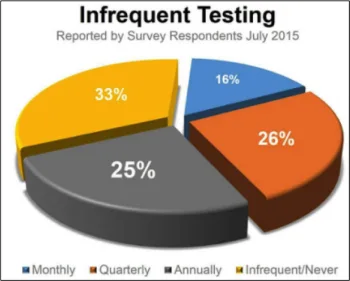Of the many traits that characterize successful businesses, preparation for the unknown is typically high on the list. Yet many of today’s companies avoid the steps necessary to stay in front of disaster recovery. Why?
“One thing that is clear from the results [of a recent survey] is that when it comes to disaster recovery most firms have ignored best practices in favor of a patchwork of compromises that ultimately mean more work for IT departments at a higher expense and risk for business continuity exposure for most organizations,” according to CloudVelox.
 The core of the problem is that most companies today test the viability of their business continuity far too infrequently to be impactful. As CloudVelox discovered in their survey, more than half of respondents admitted to testing for disaster recovery less than once a year while a full one-third said they prepped for disaster recovery infrequently or never.
The core of the problem is that most companies today test the viability of their business continuity far too infrequently to be impactful. As CloudVelox discovered in their survey, more than half of respondents admitted to testing for disaster recovery less than once a year while a full one-third said they prepped for disaster recovery infrequently or never.
The good news for managers is there are a number of relatively easy and cost-effective steps that can be taken to address disaster recovery. First, it is important for leaders to recognize disasters are not confined to the natural, such as hurricanes, floods, etc. which caused $50 billion in lost productivity and 76,000 lost jobs in 2014, but also to man-made problems set deliberately and unintentionally. “As damaging as natural disasters can be, more often than not, non-natural disasters, such as power and internet outages, cause the most damage,” notes UC Tech Chat.
More good news is that the cloud-based Disaster Recovery-as-a-service is gaining traction. The expense of relying upon DRaaS is much lower for customers than a traditional disaster recovery plan because all subscribers share in the cost of operating the data center. Businesses also do not need to retain in-house experts to architect, deploy, test and to manage disaster recovery operations; instead, “they can now rely on the expertise and plug-and-play services of the cloud provider,” Forbes reports. Finally, some DRaaS offerings allow users to pay for services on-demand. In other words, users only pay for the service when it is actively used in a failover event.
Despite all of the bells and whistles that come with shiny new technologies the key to disaster recovery remains buy-in from management. The only way disaster recovery will become a priority for companies are if key decision-makers are true believers of its importance. “For most firms, it is management by checkbox and denial, which leads to a complex and hard to maintain process.” Hopefully, this will continue to change as disaster recovery becomes more easily accessible and palatable for managers.
